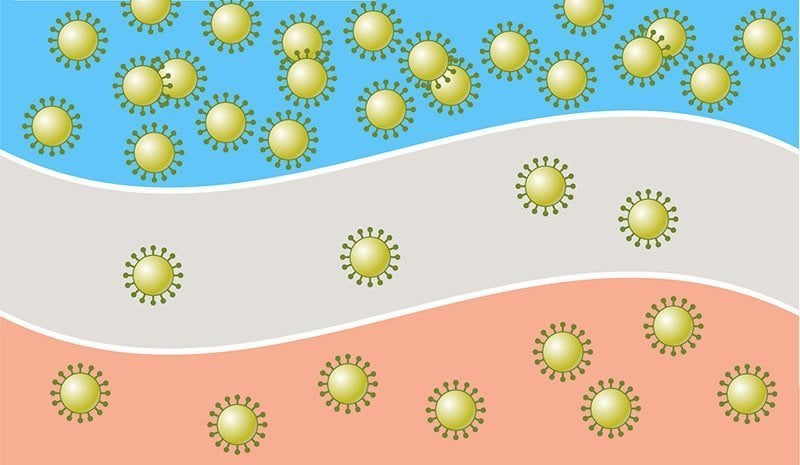Summary: In addition to physical distancing and improved personal hygiene practices, the seasonal moderation of relative humidity indoors could help slow rates of transmission for COVID-19. However, the virus can still be transmitted via contact and close proximity to those infected, regardless of the season, researchers warn.
Source: Yale
How much spring and summer affect the COVID-19 pandemic may depend not only on the effectiveness of social distancing measures, but also on the environment inside our buildings, according to a review of Yale scientists of their own work and that of colleagues on how respiratory viruses are transmitted.
The cold, dry air of winter clearly helps SARS-CoV2 — the virus that causes COVID-19 — spread among people, Yale research has shown. But as humidity increases during spring and summer, the risk of transmission of the virus through airborne particles decreases both outside and indoors in places such as offices.
While viruses can still be transmitted through direct contact or through contaminated surfaces as humidity rises, researchers suggest that, in addition to social distancing and handwashing, the seasonal moderation of relative humidity – the difference between outside humidity and temperatures and indoor humidity — could be an ally in slowing rates of viral transmission.
The review was published online the week of March 23 in the Annual Review of Virology.
“Ninety percent of our lives in the developed world are spent indoors in close proximity to each other,” said Yale immunobiologist and senior author Akiko Iwasaki. “What has not been talked about is the relationship of temperature and humidity in the air indoors and outdoors and aerial transmission of the virus.”
Iwasaki is the Waldemar Von Zedtwitz Professor of Immunobiology and professor of molecular, cellular, and developmental biology at Yale, and an investigator for the Howard Hughes Medical Institute.
Iwasaki said the seasonal nature of respiratory illnesses have been chronicled since the times of the ancient Greeks, who noted such illnesses rose in winter and fell during spring and summer. Modern science has been able to identify cold, dry air as a factor in spread of viruses such as the novel coronavirus causing COVID-19. Research by Iwasaki’s lab and others explains why.
Winter’s cold, dry air makes such viruses a triple threat, Iwasaki said: When cold outdoor air with little moisture is heated indoors, the air’s relative humidity drops to about 20%. This comparitively moisture-free air provides a clear path for airborne viral particles of viruses such as COVID-19..
Warm, dry air also dampens the ability of cilia, the hair-like projections on cells lining airways, to expel viral particles. And lastly, the immune system’s ability to respond to pathogens is suppressed in drier environments, Iwasaki has found.
Iwasaki was interested in the effects of relative humidity During the winter, relative humidity remains low in most indoor environments; the cold, dry outside air is simply reheated and circulated throughout homes and offices.

Iwasaki’s review cites experiments that show rodents infected with respiratory viruses can easily transmit viral particles through the air to non-infected neighbors in low-humidity environments.
“That’s why I recommend humidifiers during the winter in buildings,” Iwasaki said.
However, in areas of high relative humidity such as the tropics, airborne infectious droplets fall onto surfaces indoors and can survive for extended periods, she said.
“Many homes and buildings are poorly ventilated and people often live in close proximity, and in these cases, the benefits of higher humidity are mitigated,” Iwasaki said.
There is a sweet spot in relative humidity for indoor environments, review found. Mice in environments of between 40% and 60% relative humidity show substantially less ability to transmit viruses to non-infected mice than those in environments of low or high relative humidity. Mice kept at 50% relative humidity were also able to clear an inhaled virus and mount robust immune responses, she found.
Iwasaki stresses that these studies only apply to aerosol transmission: the virus still can be shared at any time of year between people in close proximity and through contact with surfaces containing sufficient amounts of virus. That is why people living in warm countries and people working close to each other are still susceptible to infection, she said.
“It doesn’t matter if you live in Singapore, India, or the Arctic, you still need to wash your hands and practice social distancing,” Iwasaki said.
Yale’s Miyu Moriyama and Walter J. Hugentobler of the University of Zurich are co-authors of the paper.
Source:
Yale
Media Contacts:
Bill Hathaway – Yale
Image Source:
The image is credited to Yale.
Original Research: Closed access
“Seasonality of Respiratory Viral Infections”. Miyu Moriyama, Walter J. Hugentobler, and Akiko Iwasaki.
Annual Review of Virology doi:10.1146/annurev-virology-012420-022445.
Abstract
Seasonality of Respiratory Viral Infections
The seasonal cycle of respiratory viral diseases has been widely recognized for thousands of years, as annual epidemics of the common cold and influenza disease hit the human population like clockwork in the winter season in temperate regions. Moreover, epidemics caused by viruses such as severe acute respiratory syndrome coronavirus (SARS-CoV) and the newly emerging SARS-CoV-2 occur during the winter months. The mechanisms underlying the seasonal nature of respiratory viral infections have been examined and debated for many years. The two major contributing factors are the changes in environmental parameters and human behavior. Studies have revealed the effect of temperature and humidity on respiratory virus stability and transmission rates. More recent research highlights the importance of the environmental factors, especially temperature and humidity, in modulating host intrinsic, innate, and adaptive immune responses to viral infections in the respiratory tract. Here we review evidence of how outdoor and indoor climates are linked to the seasonality of viral respiratory infections. We further discuss determinants of host response in the seasonality of respiratory viruses by highlighting recent studies in the field.







